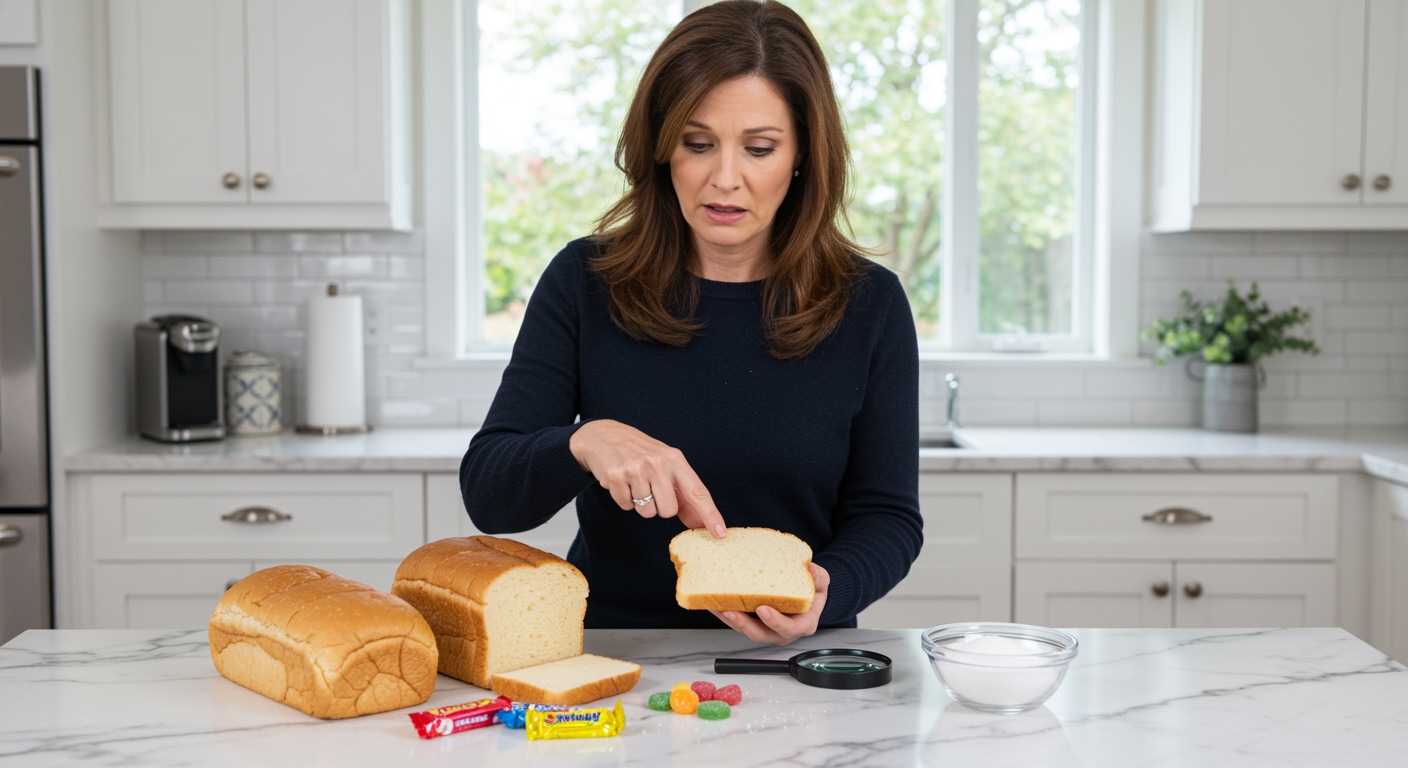✪ Key Takeaway: Commercial bread contains 2-4 grams of sugar per slice, often exceeding candy bars through hidden processing methods.
Introduction
You grab your morning toast thinking you are making a healthy choice while avoiding that candy bar in your pantry.
But what if I told you that your daily bread actually contains more sugar than most candy bars through clever processing tricks that food companies never want you to discover?
Hi, I am Abdur, your nutrition coach and today I am going to expose the shocking truth about how modern bread manufacturing creates hidden sugars that exceed those found in typical confectionery products.
How Does Bread Processing Create Hidden Sugars?
Modern bread production involves a complex process called enzymatic breakdown that transforms starches into simple sugars during manufacturing.
Food companies add enzymes like amylase and invertase to break down flour starches into glucose and fructose molecules.
This process happens before baking, which means these sugars become permanently embedded in the bread structure.
The Maillard reaction during baking further concentrates these sugars, creating that appealing golden-brown crust you love.
Commercial bakeries also add high fructose corn syrup, dextrose, and other sweeteners that do not appear prominently on ingredient labels.
Your body processes these hidden sugars exactly like candy, causing rapid blood glucose spikes and insulin responses.
Research shows that two slices of white bread can raise blood sugar levels faster than eating a candy bar directly.
✪ Fact: Enzymatic processing can increase bread sugar content by 300% compared to traditional baking methods.
What Makes Bread Sugar Content Higher Than Candy?
A typical candy bar contains 20-25 grams of sugar per 40-gram serving, which equals about 50-60% sugar content.
Commercial bread contains 2-4 grams of sugar per slice, but here is where the math gets shocking.
Each bread slice weighs approximately 28 grams, making the sugar concentration 7-14% by weight.
However, bread also contains rapidly digestible starches that convert to glucose within minutes of consumption.
These starches add another 15-20 grams of glucose equivalent per two-slice serving.
When you combine added sugars with starch conversion, bread delivers 19-28 grams of blood sugar impact per serving.
This means bread actually provides more glucose to your bloodstream than most candy bars, but the impact feels less obvious because it happens gradually during digestion.
✪ Pro Tip: Check the glycemic index – white bread scores 75 while chocolate bars typically score 40-50.
Why Do Food Labels Hide This Information?
Food labeling regulations allow companies to list only added sugars separately from naturally occurring sugars.
This means enzymatically converted starches do not count as added sugars even though they behave identically in your body.
Companies exploit this loophole by using technical processing methods instead of directly adding table sugar.
The ingredient list shows flour, water, and yeast prominently while burying sweeteners like dextrose and corn syrup near the bottom.
Marketing teams promote bread as a healthy carbohydrate source while downplaying its sugar impact through clever positioning.
Regulatory agencies focus on total sugar content rather than blood glucose impact, creating a massive blind spot in consumer awareness.
This system allows bread companies to market their products as healthier alternatives to candy while delivering similar metabolic effects.
✪ Note: Always read ingredients from top to bottom – the first five ingredients make up 80% of the product.
Which Bread Types Contain The Most Hidden Sugar?
White sandwich bread tops the list with 3-4 grams of sugar per slice plus rapid starch conversion.
Whole wheat bread contains 2-3 grams of added sugar but still converts starches quickly due to fine milling processes.
Specialty breads like honey wheat, cinnamon raisin, and multigrain varieties contain 4-6 grams of sugar per slice.
Bagels deliver the highest sugar impact with 5-8 grams of added sugars plus massive starch loads equivalent to 4-6 bread slices.
Even artisan breads from bakeries often contain hidden sugars through dough conditioners and fermentation enhancers.
Sourdough bread offers the lowest sugar impact because natural fermentation breaks down starches before baking.
Sprouted grain breads also reduce sugar content through germination processes that consume stored starches.
✪ Fact: Sourdough fermentation can reduce bread sugar impact by up to 40% compared to commercial yeast breads.
How Can You Choose Better Bread Options?
Look for breads with fewer than 2 grams of sugar per slice and minimal ingredient lists.
Choose breads made with stone-ground flour, which retains more fiber and slows sugar absorption.
Seek out true sourdough breads that use wild yeast fermentation instead of commercial yeast plus added sugars.
Sprouted grain breads offer superior nutrition because sprouting reduces starch content while increasing protein and fiber.
Make your own bread at home using simple ingredients: flour, water, salt, and natural yeast starter.
When buying commercial bread, avoid anything with high fructose corn syrup, dextrose, or more than five ingredients total.
Consider bread alternatives like lettuce wraps, cauliflower bread, or seed-based crackers that eliminate sugar concerns entirely.
✪ Pro Tip: Freeze bread immediately after purchase to slow starch-to-sugar conversion and preserve nutritional quality.
The Bottom Line
Your daily bread delivers more sugar impact than candy bars through hidden processing methods that convert starches into rapidly absorbed glucose.
Real health comes from understanding what companies hide, not what they advertise.
I would love to hear your thoughts about this revelation and any questions you might have about choosing healthier bread options for your family in the comment section below.
References
At NutritionCrown, we use quality and credible sources to ensure our content is accurate and trustworthy. Below are the sources referenced in creating this article:
- Business Insider: Breads High in Sugar
- Indian Express: Added Sugar Bread Risks
- PMC: Glycemic Differences Between Breads
- The Spruce Eats: Sugar in Bread What You Need to Know

